Wondering what to see now that Mars is at its biggest and brightest? Here are expert tips for when, where, and how to look.
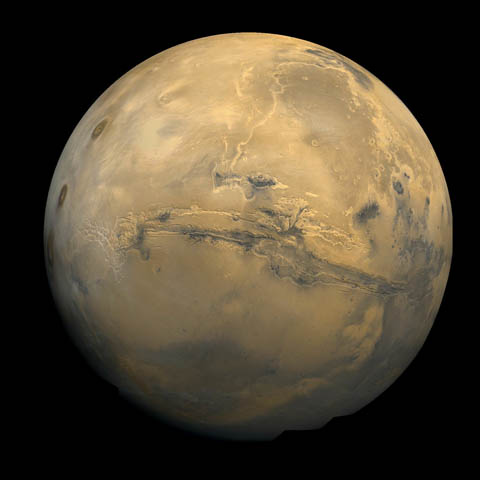
NASA / JPL
We've waited 15 long years, and now it's time to party. Mars reaches perihelic opposition — coming its closest to both the Sun and Earth at the same time — on July 27th. This hasn't happened since August 2003, meaning that Mars is bigger and bolder in the night sky than it's been in more than a decade. Are you as eager as I am to roam its deserts and poles with a telescope? Maybe even track a dust storm or catch sight of clouds capping mighty Olympus Mons?
To observe this planet at its best requires the patience of marble. At approximately two-year intervals, Earth lines up with Mars in their respective orbits. But the Red Planet has a more eccentric orbit than most, and most of the alignments with Earth occur when Mars is relatively far from the Sun.
Not this year! Mars reaches opposition (July 27th) just a few weeks before its perihelion (September 16th). So at its closest Mars will be a snug 0.38 astronomical unit (38.5 million miles or 57.6 million km) away from Earth, close enough for telescopic observers to have a field day ferreting out dark surface markings and changeable weather.
When to Look for Mars
On the night of opposition, in the company of the waxing gibbous Moon, the Red Planet will burn an intense magnitude –2.8, equaling Jupiter at peak brightness. That's a lot of light to muster for a tiny planet only twice the diameter of our Moon. It just goes to show how distance trumps size when it comes to things celestial.
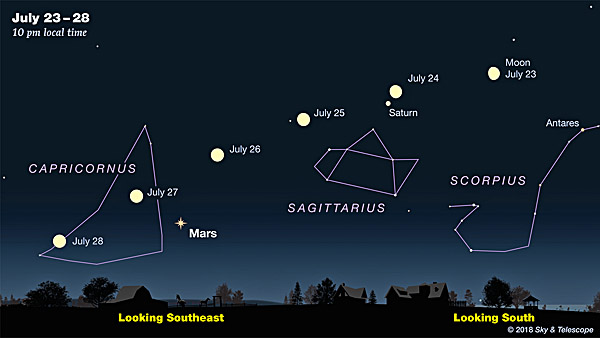
Sky & Telescope / Gregg Dinderman
At the same time, the planet's disk will balloon to 24.3″ (24.3 arcseconds, with 1 arcsecond being 1⁄3600 of 1°). that's only 0.8″ smaller than during the 2003 opposition, when Mars came its closest to Earth in 59,635 years. Because Mars won't arrive at perihelion until September, its closest approach to Earth is slightly delayed, occurring on July 31st. After that date, the two planets begin to part ways.
June opened with Mars already 15.5″ across and shining at magnitude –1.2, nearly the equal of Sirius. By July 1st, it had filled out to 21.1″, and it reaches its greatest size at month's end.
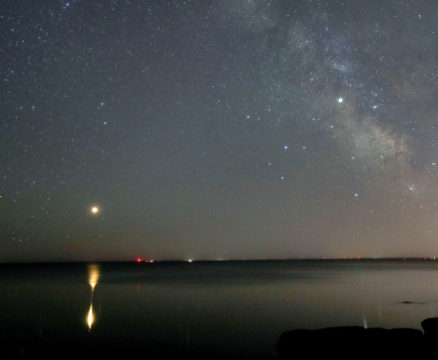
Bob King
Despite its glorious girth, northern observers will pay a price during this juicy Mars apparition. At most perihelic oppositions, including this one, the planet retreats to the belly of the ecliptic low in the southern sky. On July 27th, Mars gleams from southwestern Capricornus at declination –25.6°, so at culmination it stands only 23° high from Chicago and 13° from London. Low altitude often means more air layers to peer through, resulting in increased turbulence, poor seeing, and soft images.
Your best strategy is to observe the planet as often as possible to maximize the chance of getting a sharp look during infrequent spells of excellent seeing, when all dross falls away and the planet looks as real as being there. (Remember to allow your telescope's optics to cool to the outside temperature, so they don't become their own source of "boiling" air.) Mars won't be this close to Earth again until September 2035, a simple fact that motivates many a Mars-watcher to put eye to eyepiece every clear night around opposition.
Don't fret about trying to view Mars when it maxes out at month's end. It'll still be 24″ across on August 10th, 23″ on August 20th, and 21″ on the 31st. So just find the clearest nights with the steadiest atmospheric conditions.
The Red Planet remains in Capricornus throughout the summer and early fall, making a brief foray west into neighboring Sagittarius near the end of its retrograde loop in late August. Minimum declination of –26.6° occurs on August 15th before the planet finally comes up for air in mid-October. When the kids knock on doors for Halloween candy, Mars will still be in negative magnitudes, 12″ across, and perched at declination –17°.
To see all the wonderful features noted below at their best, look when Mars is high enough to clear the atmospheric muck. Best viewing times in late July to early August are from about 11:30 p.m. to 2:30 a.m. local time. From mid-to-late August you can begin as early as 10 o'clock.
What to Look For
The planet's South Polar Cap (SPC) will highlight the first half of the apparition. Tipped in our direction, this brilliant button of frozen water and CO2 looked big and bright as it emerged from its winter hood of clouds in late April and May.
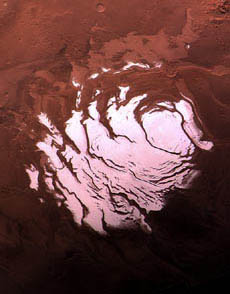
NASA / JPL
Watch it gradually shrink and rift as opposition approaches. We'll also see part of the North Polar Hood (NPH), a dull, diffuse cap of clouds shrouding the North Polar Cap. Look for it along the planet's northern limb throughout the summer and early fall. The NPH is often confused with the much brighter, more distinct true cap, but that won't be visible until mid-winter 2019.
Spring in Mars's southern hemisphere began on May 22nd with the cap at its maximum extent. North of the SPC, keep a wary eye out for another polar cap look-alike: Hellas, an enormous impact basin that's 1,400 miles (2,300 km) across. Hellas can sometimes be hidden under a blanket of clouds, mimicking the appearance of a polar cap, but you can tell the two apart because Hellas itself appears duller. Even small scopes should provide great views of these polar features.
Besides the Moon, Mars is the only planet that readily reveals bright and dark surface features (called albedo markings) across its orange globe. Some of these change shape with the seasons or from apparition to apparition depending on how the Martian winds move bright surface dust around.
The most obvious southern hemisphere features include Syrtis Major, an ancient shield volcano shaped like the subcontinent India; the "chicken drumstick" combination of Sinus Sabaeus and Sinus Meridiani (east of Syrtis Major); the great bands of Mare Tyrrhenum and Mare Cimmerium that stretch west of Syrtis Major; the vast and amoebic complex of Mare Erythraeum and Aurora Sinus; and the dark eye of Solis Lacus.
In the northern hemisphere you can't miss the dark thumb of Mare Acidalium and Niliacus Lacus located at the same longitudes as Mare Erythraeum. Identifying albedo markings takes time and patience on your part. Most are subtle and difficult to pick out against the glaring orange landscape. But with practice, they become easier to see until you recognize them like continents on a globe. To make the task easier, observe the planet with as much magnification allowed by the seeing conditions. I've always found a red (Wratten #23A) filter a big help in boosting their contrast.
This is especially true when viewing Mars's "boring" hemisphere, located roughly between longitudes 110° and 240° west, which includes the narrow polar-hugging stripe of Mare Sirenum and the low contrast volcanoes of the Tharsis Plateau. Orographic clouds often cover Olympus Mons, the planet's largest extinct volcano, making it look like a pale, white pustule in the ochre desert.
Dust Storms, Clouds, and Hazes
Dust storms can and do occur on Mars — and they sometimes engulf the entire planet. This last occurred in June 2007 and within a few weeks had blanketed nearly every feature from view. Such dust storms are common during the Martian southern summer, which begins in mid-October. Visually, they start off as bright, yellow patches. A red (Wratten #23A) filter will brighten and enhance the view and serve to confirm that you're seeing dust and not water vapor clouds.
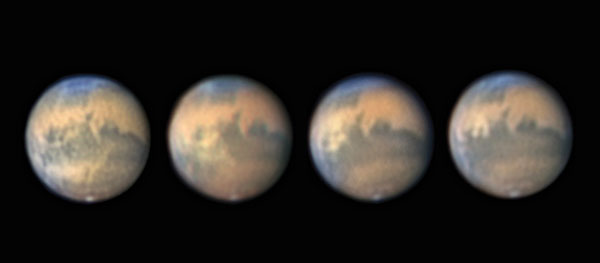
Alas, the dusty onslaught arrived a few months early this time around, and observers are once again struggling to view the Martian surface through a veil of high-flying dust that erupted in late May. As of mid-July things are still pretty bad, though at least they're not getting worse.
Of course, Earth has dust storms too — though they're not nearly so bad. These two planets share other atmospheric similarities too. Both exhibit clouds, fog, and mist. On Mars, they often appear as narrow bands of white haze along either the morning or evening limb where the Sun is just rising or setting. In my experience, these are the most common clouds visible in amateur telescopes, but watch for isolated puffs and high-altitude clouds that hug Martian volcanoes. A blue (Wratten #80A) filter will enhance their visibility.
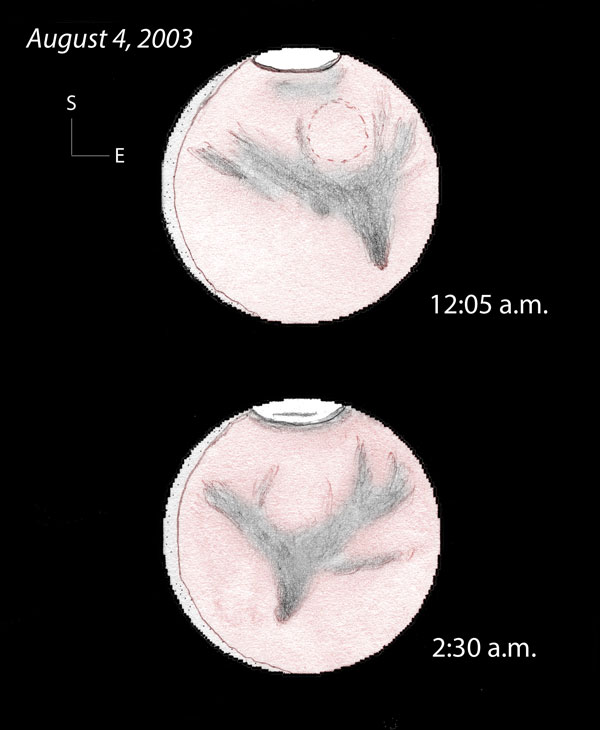
Bob King
In the opposite hemisphere, autumn will be underway during Earth's summer and fall, with clouds forming over the North Polar Cap and beyond to create the North Polar Hood. By October, the NPH may extend as far south as 50° N, giving the "top" of Mars a diffuse, off-white cast as if it had been dipped in milk. Isolated clouds can appear anytime especially as the South Polar Cap shrinks through the summer and fall.
No Telescope? Try this
If you've seen Jupiter as a disk through a pair of binoculars, you can try to do the same with Mars. Daniel Costanzo, with the Washington Academy of Sciences, was able to discern Mars as a disk through his 8x56 glass. He recommends looking about a half-hour before sunrise and a half-hour after sunset, when the sky is still bright. Otherwise the glare of the planet in a dark sky makes it nearly impossible to see its true outline. Costanzo points out that you can do this activity even from the heart of a big city as long as you can find a clear sight line.
Mars' low altitude makes it easier to hold the binoculars steady although attaching them to a tripod or holding them against a wall or post will provide the steadiest view. If you try succeed in this observational challenge, please let us know by leaving a comment.
Beware the "Mars Hoax"
Finally, who could forget the internet rumor started in 2003 about Mars appearing as big as the full Moon at opposition? The virulent e-mail that bounded from inbox to inbox was, surprisingly, was mostly true, as it claimed Mars through a 75× eyepiece would look as large as the full Moon to the naked eye.
Then an unfortunate thing happened. As the e-mail made the rounds, the reference to "at a modest 75-power magnification" was left out, leading neophyte skywatchers to expect a frighteningly large, Moon-sized Mars in the sky casting a rusty specter over the landscape. Like a mosquito you hear but forever fail to swat, the description has popped up at every subsequent opposition. Watch for it to reappear on schedule this apparition — and when friends ask what's up, patiently explain and then direct them to the real thing right outside their window.
Useful Resources
Although the internet is often a tool for rumor-mongering, it can also provide good information for planetary observers. Here are a few sites to visit during this opposition of Mars.
• Sky & Telescope Mars Profiler
(A snapshot of the view you might see through your optics at the current date/time is below. Click on the link to customize to a different date and time)
• Association of Lunar and Planetary Observers (ALPO) Mars Section
• The 2018 Perihelic Opposition of Mars
• How to Make An Occulting Bar (for spotting tiny Phobos and Deimos)
• Communications in Mars Observations (latest images from a global observer network)
• Mars Observers Yahoo Group
An earlier version of this article appeared in Sky & Telescope's July 2018 issue.
 5
5









Comments
Anthony Barreiro
July 24, 2018 at 5:33 pm
The last paragraph of the "When to Look for Mars" section is a little out of date:
"To see all the wonderful features noted below at their best, you'll need to observe around the time of dawn when the planet is high enough above the muck for a good look. Mars won't be conveniently placed for evening viewing until early August."
Now Mars is highest around true midnight, i.e. 1 a.m. daylight shifting time.
You must be logged in to post a comment.
Bob KingPost Author
July 24, 2018 at 9:03 pm
Thanks, Anthony. This is an edited piece from the magazine. I will gently update 🙂
You must be logged in to post a comment.
Anthony Barreiro
July 25, 2018 at 3:30 pm
Thanks Bob. I enjoyed the article in the magazine, and I enjoyed rereading it here on the website. Martian perihelic oppositions are a big deal!
🙂
You must be logged in to post a comment.
misha17
July 24, 2018 at 5:47 pm
I wonder how many casual viewers Europe, Africa and western Asia who get an email about the Mars Hoax will look up on the night of July 27th see a large red object (the eclipsed moon), and think, "Wow Mars ~really~ is big tonight?"
You must be logged in to post a comment.
Bob KingPost Author
July 24, 2018 at 9:15 pm
Misha,
That's pretty humorous. And yet someone might just make that mistake. I'm glad you took notice.
You must be logged in to post a comment.
You must be logged in to post a comment.